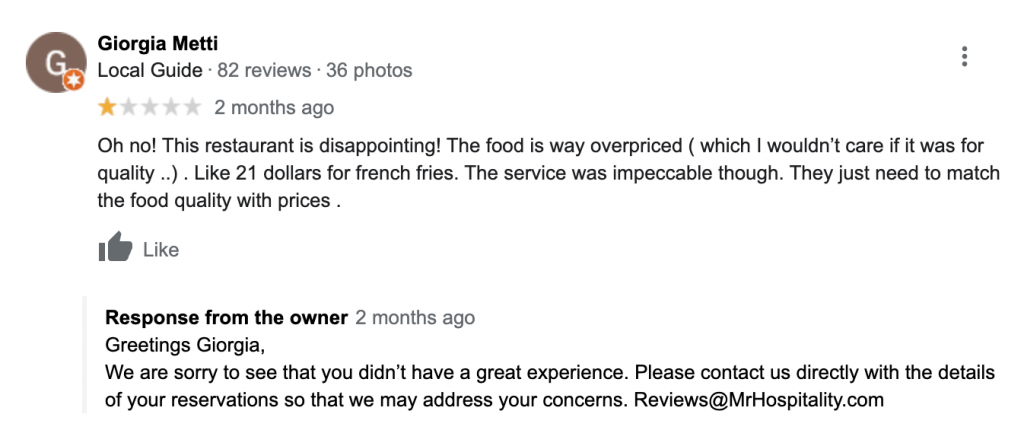When we meet a new local business owner the first thing they ask us is always the same: “Can you remove my 1 star reviews?”. No, we can’t, but we can tell you how to deal with them to turn them around or at least minimise their impact. There’s a lot to cover so let’s get started.
The basic framework on how to deal with 1 Star reviews is as follows:
- Avoid
- Report
- Fix & convert
- Respond
- Acknowledge
- Investigate
- Explain
- Deflect
But before we start, it’s key to understand that having 1 star reviews happens and can’t be avoided. The damage we can get from them is not dealing with them properly. As this reddit user explains, we all understand that things can go wrong, what matters is what the business does in this situations in case it happened to us.
1 – Avoid
Yes, it looks like obvious but:
the best way to deal with 1 star reviews is not having to deal with them
To avoid getting 1 star reviews it’s very important to understand this:
- Fix what users are complaining about. They won’t stop doing. it. If you have complaints for a specific issue and you are not solving it, customers will keep complaining about it, like it or not. Let’s take one of our users. This italian restaurant in the center of Barcelona was being crushed on reviews by the slow service. The reason? He has a tiny kitchen and can only serve so much people. The solution? He started admitting less customers: his ratings climbed again and he’s having the best results ever.
Whether it’s service, cleanisness, quality, speed or a rude seller, use the negative reviews to learn from them and make that 1 star review be the last one you’ll get. - Give unsatisfied users a way to complain (internally). If you provide an online service you should have an internal review system to gather feedback internally so they address their frustration internally. Remember that Google Business Profile policies prevent from filtering who can review your business, so if your redirect only to Google Maps the best reviews (you wouldn’t be the only one doing it), do it at your own risk.
if you are a local business and you don’t have the customer contact details make sure that you identify any unhappy customers while they are in your location so you can deal with them “onsite”. Most of the times we just want to be listened to. This will prevent the user from going all over the internet to complain and maybe changing that 1 star review for a positive one as the issue was acknowledge and hopefully solved.
2 – Can it be reported?
If you couldn’t prevent the bad review from happening the next question we need to raise is: can it be flagged and removed? It depends on the content of the review and whether it violates the Google Policies.

The top 3 reasons that can make a 1 star review are:
- The review contain insults or profanity
- The review contains private data
- The review is clearly not related to your business…
Check the full list of restricted content here.
Important: Reviews can’t be flagged for not being “fair”, “factual or “appropriate”. Google does not judge nor verifies that the information is correct.
If the review is fake or spammy the Google Algorithm should take care of that. The problem here is that the Google Algorithm is filtering as spam / fake many legit good reviews, which has been covered here.
3 – Fix it and convert it in a good review
This is important:
The first hours after the bad experience happens are crucial to get any chance of turning the bad review into a positive one.
It’s totally possible to convert a bad experience into a good review: there are misunderstandings, accepted mistakes, minor slips that can be fixed… and most of times they won’t translate into 1 star reviews. Maybe a 3 stars one if everything else is OK.
When we leave a 1 star review is because we were mistreated: our booking was canceled, we felt insulted, we were not given a timely apology or similar.
And all these issues can be addressed, but it has to be done quickly. While the experience is fresh. The apologies or refunds made 3 days later rarely change a negative review.
In the next sections we’ll see how to properly turn around these bad reviews.
4 – How to respond with a -legitimate- 1 star review?
It’s time to respond and, as we said before, SPEED matters here. To have a chance to change it you must act swift. These are the right steps to take:
Acknowledge
The first thing you have to do is to answer the review straight away with a “acknowledge / we are on it” message. That will prevent the damage to spread if the customer is specially annoyed and wants to keep amplifying its insatisfaction. Of course you’ll change this reply later.
Investigate
If you are not in the location call straight away. Most of the times the staff is well aware that someone left unhappy (back to the first point of prevention, that should never happen). If they don’t try to get as much info about what happened. Hopefully the review was processes quickly by Google and it doesn’t take many hours to arrive. This is a long shot, but it’s worth asking if the customer is already there and talk to them in person.
Once you can get the customer on the phone, 99% of complaints are solved.
Explain
Whether this investigation phase works, and the user changes the review, or not, that’s when you explain what happened. And this is crucial: everybody is watching. And everybody reading that explanation is thinking “that could happen to me too“. So, how do you react to this public audit?
- Be human. Avoid scripted answers like this:

- Be honest. Everyone messes it up. If you, or someone in your business, screwed up, that’s OK to say “we did not well” and apologize.
- Be accountable. If you caused any harm, you should be accountable for that and repay the damage caused to the user. i.e. “They canceled my hotel without notice by overbooking, I was stranded at night in a foreign city and had to pay for another hotel”. That customer probably deserves more than a apology from the social media person. Maybe a free night in the hotel (within the chain) of its choice.
If the resolving contemplates some sort of return, reparation or compensation for the customer: do not mention it in the public explanation. Try to handle it privately with the customer. Otherwise you are sending the message: “complaint and get it for free” which I’ve seen in several cases. People will abuse of your willingness to fix things. - Respect. If you don’t agree with the customer perception, respect their reality and allow them to feel unsatisfied with you, don’t try to make them change their minds. The rest of users will appreciate this. This doesn’t mean that you tolerate to be bullied or insulted. In the worst case you can use something like “We are sorry that you felt this way, this is what happened and how hard we tried to solve whatever problem you had“. The goal is not anymore to convince that customer, but the audience, that we are the good ones here.
So, in a human, honest, humble and respectful way explain what happened and how you tried to solve it for the user if that was something to be fixed.
5 Deflection
The last tactic or play in the book is to “deflect” the impact of the review. Normally this is used to handle fakes, trolls, spammers or similar reviews that are not filtered out by Google, can’t be flagged either, but we know -for sure- are fake. Triple check that this is so, a real user treated like a fake could ignite his aggressivity to the infinite. So, what’s deflection? It’s creating the doubt, in a subtle way, that the review can be fake. This is overused, so must be done carefully. “Dear XXXX. We are sorry that you had a bad experience with us. I would like to know more about your case, but we can’t find any reservation / visit / order etc under your name, and noone in the shop / restaurant / location recalls this specific episode. We have very transparent policies regarding these type of situations and I have no doubt that our team is telling the truth. I’ll be waiting to hear from you at this email XXXXX to clarify the situation“. Basically you are showing that the review is fake.
Wrapping up
There are no tricks, cheats or hacks when it comes to Google Reviews. That’s why they are the most trusted reviews among consumers. No matter how smart your SEO guy is. Google is Smarter. This post explains a probed and successful process for business who genuinely want to learn how to deal properly with 1 star reviews and improve their customer satisfaction.
How do you deal with 1 star reviews? Let’s talk in the comments.


